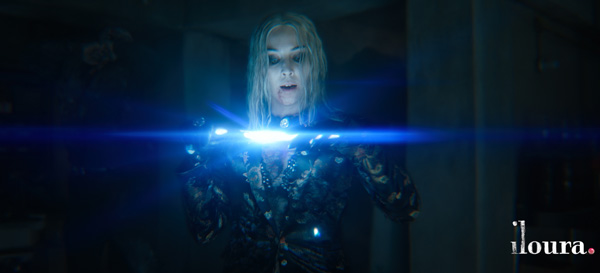
In the Netflix film 'Bright', directed by David Ayer, human beings live and work side-by-side with fantastical creatures – in close proximity perhaps, but not in harmony. The magical version of Los Angeles they share is, in fact, marked by interspecies tension and its magic is ominous. The main protagonists are two police officers, Officer Daryl Ward and his orc partner Nick Jakoby, who work their way together across an unsettled, enchanted LA, populated by edgy fairies, dragons, orcs and elves.
Iloura was lead visual effects vendor for 'Bright', led by VFX Supervisor Jason Billington, and were responsible for the looks of the environment, some of the creatures and many key magical effects. The entire film was shot in LA, and from that start point, Jason and his team worked to create an alternate world that felt completely real and believable, with a look that was different from more traditional fantasy films. He said, “Our challenge was making it realistic yet magical, using science fiction for inspiration. This version of Los Angeles could be happening while you sleep – it’s everything you know, but with a magic vibe.”
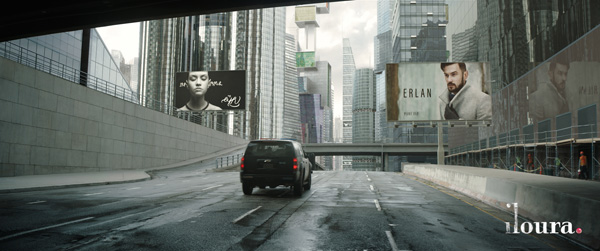
To create the film’s main setting of downtown Los Angeles, Iloura digitally modified the city’s existing skyline to create the elite Elf Town, segregated from the rest of the population. Using reference photography and satellite imagery, their task was to create contemporary building designs to add to the Los Angeles skyline, easily recognised as LA but with an extra 'Elvish' spin on the buildings.
Elf Town
Jason said, “During pre-production, we were supplied with some impressive and inspiring artwork that really helped get our minds around what we were creating and working on. It was great to get this from the start, as it really got all the artists excited about the project and thinking early on about the challenges we might face.
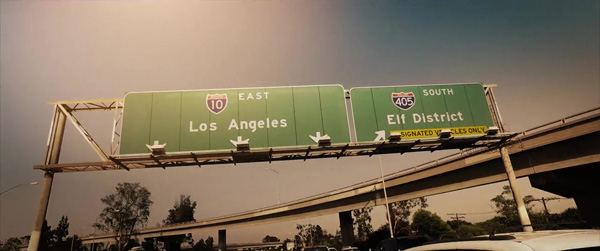
“The Elvish people in the world of 'Bright' are rich - shiny, clean and sophisticated - and love gold. We referenced modern architecture from around the world, as well as creating our own modern buildings. We built Elf town as a 3D environment, so no matter where a sequence was taking place, we had the correct layout for any given angle and position. We were also constantly changing the street signs, cleaning up imperfections on street surfaces, and removing any foliage.
“I visited the set for a couple of days during principal photography, mainly to meet with the production crew and get a good feel for how the scenes were being shot and developing during the shooting stage. Throughout production, a team of four or so artists were there, gathering set and reference photography, scans and all the data and info we would need in post.”
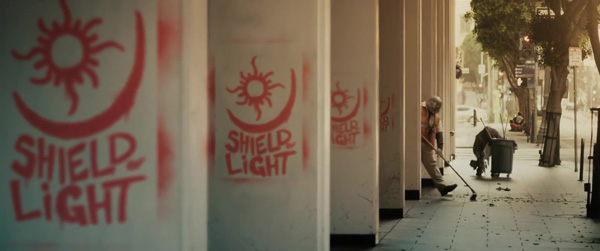
Iloura also had a chance to contribute to the movie's essential creatures, modelling, texturing and animating one of the fairies and centaur. “For the centaur, we discovered early on that a human head and torso on a horse’s body looks ridiculous in most cases,” Jason said. “For a believable centaur, we had to work on the proportions and find the correct balance between the horse and human elements. Then we added digital SWAT armour to the final creature. Creating convincing animation required a similar process of trial and error to find the right movements.”
Frightening Fairy
What was perhaps more interesting was the fairy because, in the 'Bright' universe, fairies are considered menacing pests, not charming winged friends. When one of them is caught eating seeds from a bird feeder outside Officer Ward’s house, he bashes and kills it with a broom. With a brief describing the fairy’s movements as similar to a hummingbird's, Iloura designed and built the fairy from scratch, covering its body in tiny feathers and creating a vicious, degenerated little face.
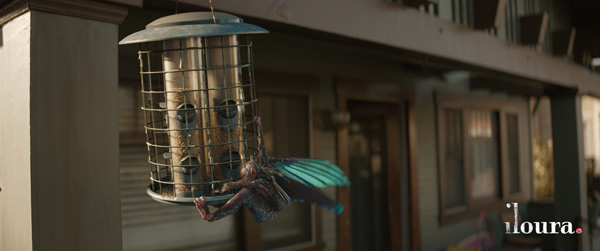
The team was aware that, as a small humanoid character with iridescent colours, the fairy risked appealing to the audience. “Look development started off with a life size maquette built by the production team," said Jason. "The iridescence of the feathers was certainly one of the trickiest features to get right. Because the effects of iridescence are only visible when the surface is in motion, we had to render sequences rather than single frames before we could tweak the look development. To guide us, we looked at insects with a structured cellular construct to their wings, producing a view-dependent colouration.
Aggressive
“The character of the fairy was just as important to the lookdev process. The way it moved and the effect of its erratic speed tended to change the fairy's look when compared to a static turntable render. Consequently, the fairy posed some really interesting challenges for the animation team. We had to take what we knew as traditional fairy traits and completely flip them. In this movie, these guys are pests, like vermin – super aggressive and manic, and not afraid to attack.”
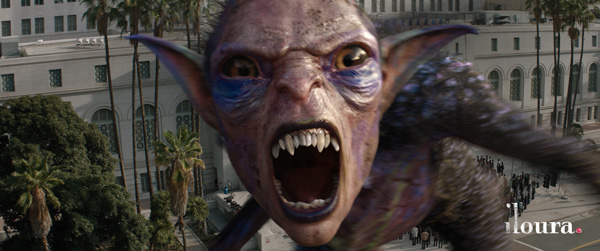
Aiming to bump the intensity of the performance up to 11, each frame of animation had to show tension and aggression. They avoided graceful poses and actions to keep the fairy looking gnarly and grimy, especially in the way it flies. They used reference footage of hummingbirds for the little darts and plateaus, and kept the attitude through the body in what they referred to as the 'battle pose', staunch and purposeful. The wing speed called for many motion samples for the geometry - an expensive operation for rendering, but it produced the desired results.
“It was especially important to nail the performance so that when Ward swats the fairy out of the air, the audience thinks, 'Yeah, that creepy little thing had it coming!' - before he gives it one last whack with his broom,” Jason said.
Magic Wand
Central to the film’s story is a magic wand, an ancient and powerful object, equally sought after by gangsters, corrupt elements within the police force, and influential elves. When LAPD officers Daryl Ward and Nick Jakoby accidentally come across the wand, they are swept up in a massive battle between the forces seeking it.
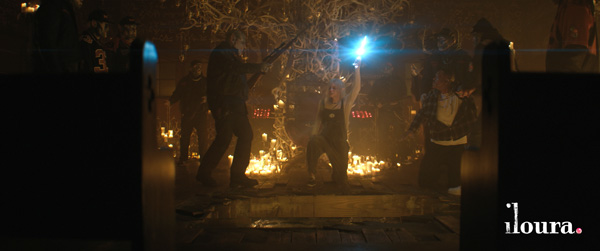
The wand exists in two states. In its inactive state, it is made of a simple bone-like material, but when activated, it becomes a brilliantly illuminated weapon, erupting with flares, smoke and a powerful, pulsating aura. Each time it takes on its active state in the story, which happens in quite a few shots, Iloura removed the practical wand in post and added a CG element in its place. After careful look development and many iterations, the team arrived at its final activated appearance with a glass or crystal-type texture revealing a bright white tip and glowing blue core. Its surface shows very intricate details and scarring that are maintained throughout the entire movie, no matter how bright the wand became.
“The practical wand was wrapped in tiny LEDs to create interactive light on the actors' hands, faces and anything else the wand interacted with. One of the challenges affecting the onset prop was that it pulsated. Due to some post-shoot creative changes, we needed to remove the pulsating lights in compositing, which was tricky,” said Jason.
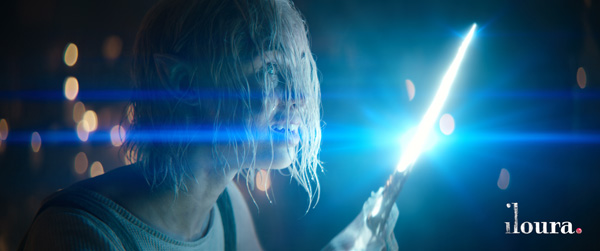
“For the FX emerging from the wand, we primarily used a 2D warp approach with some lens flares added over the top, after lots of experimentation involving 3D as well. The wand needed to be very bright and powerful, distorting the air around it and exerting its control over not just the person holding it, but also the lens that was trying to film it. We were warping and distorting the background too, very slightly, but enough to add some chaos and confusion, so that even the viewer of the film knew they too couldn’t touch the wand.”
Their general approach to the magic VFX for 'Bright' constantly referenced real world physics. Director David Ayer liked to call it 'real world magic' and wanted to avoid fantasy 'Harry Potter'-style magic. Jason noted, “We constantly referenced scientific tests such as the explosive movement of water through a firefighter’s hose, or how certain objects might react in a small science beaker when various elements were added to it. It definitely made for some fun reference gathering.”
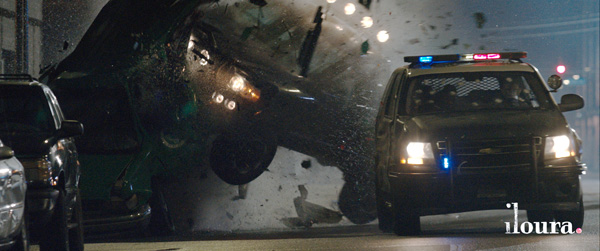
Collision Course
Iloura created a spectacular slow-motion collision sequence in which a vehicle, an SUV, crashes into an invisible perimeter created by the wand. The action was shot in a carpark in front of a long green screen, using wires connected to the front of the SUV to pull the it along the required trajectory. Once the wire was at full extension, it brought the SUV to a stop, pulling out the internals and crumpling the front bumper.
The practical SUV was set up to be destroyed and come apart fairly easily. Working with this element, the artists built the SUV and environment completely in CG and match-moved its crash in the shots including the crumpling of the front, achieved by the creature department. Having the CG SUV allowed them to re-project the green screen plate onto it, and re-position and separate elements throughout the shot. They built up the rest of the scene by incorporating several layers including further live action plates, debris, smoke and shockwave effects.
“The 'wall' itself was a Houdini smoke simulation driven by a particle simulation which we used as both a lens distortion map and actual smoke render. Other wires had been used during the shoot to create the motion of the impact across the set,” Jason said. “We wrote a Renderman lens shader that was able to read a sequence of images and skew the focal length based on the values of the map. We rendered the smoke simulation and normalized the values to then drive the shader along with the camera. That way, it created a 'true' distortion effect with no smearing artifacting, often seen in 2D solutions, and it also meant the renders were not degraded by filtering the resulting pixels.”
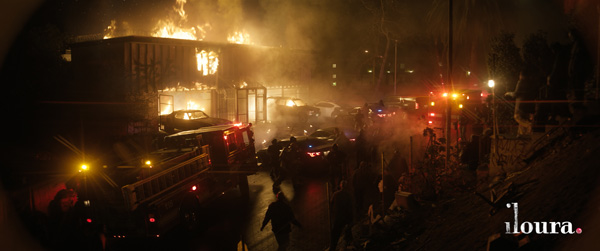
Virtual 360° Camera Pan
Using original photography for reference, as well as LIDAR scans and geometry of the set, a virtual environment was also built to accommodate a complex 360° camera pan from the vehicle’s driver to the passenger in the backseat during the moment of impact. “The interior shot involved a number of elements, starting with three plates of the talent shot separately on green screen, and stitched together - one for the driver Nick Jakoby, one for the passenger Daryl Ward, and a third for the back seat passenger," said Jason.
“The plates then needed to be projected onto a 3D model of the SUV interior. Once this material was lined up correctly and retimed, we added all of the invisible wall distortion and smoke elements, as well as a CG crumpling car front, and extra atmosphere and flying bullets for the inside of the SUV cabin. All of that was then composited onto the underpass environment we had built for the sequence in CG.” www.methodstudios.com


















